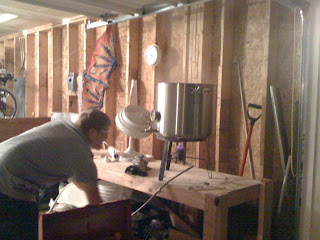Sunday 3/11/2012 - Seattle, WA - Brew Day Log Entry
Honey IPA
Batch Size 12.5 Gals
Fermentables:
42 Lbs Cambrinus Base (Grain)
3.5 Lbs Cambrinus Honey (Grain)
Hops/others:
8 oz Simcoe 12.2AA @60Min (Pellet)
4Tbs Irish Moss @30Min (Pellet)
Yeast:
2 packages - Wyeast American Ale 1056 (Liquid)
Mash:
Mash In @ 160F @ 9:30AM-12:30PM
Boil:
Start heating brew for boil @ 1:30PM
Begin Boil @ 2:30PM addition - 8oz Sincoe @ 2:30PM
add 4Tbs Irish Moss @ 2:55PM
Dry Hop addition - 4 oz Simcoe on 3/17/2012 to fermenter
Ferment:
Starting Gravity 1.071
Terminal Gravity 1.010
Alcohol Content 8.1%
Starting Volume 12.5 Gals
3/21/2012
So here it is, The first brew of the season. I just got custody of my brew kettle, as me and my buddy Kevin went in on it together. We should have anticipated the distance between us as an obstical (considering that we live 106 miles apart) However with the brew kettle clean, gleaming, and happy in my garage. It's off to the races.
I just brewed my first successful/unsuccessful brew of the year. It really depends on what you consider a success. I was trying to brew a Honey Blonde ale. Light, golden, full flavored, lightly hopped, 5% ABV... and so on and so forth, but fate is a cruel temptress. I added 6lbs of extra base to the mash (by mistake). How in the world! Right? I was adding in increments of 6lbs and miscounted. It's a large mistake it is, and it threw off my starting gravity by a lot.
I was trying for a nice 1.055 and I got a... Are you ready for this? Drum role... 1.071 The dark clouds let them gather will I let them ruin my parade.
In the words of Kevin, "I dry hopped that shit." Not only did I brew with too much grain I sparged with too less water. My final volume was just 12.5 gals, a far cry from the 14.5 I was hoping for. I just can't bring my self to dilute the wort with distilled water. Not yet at least.
So in the hopes of brewing a great, light, full bodied, sipping, yard work day ale. Now i think you can honestly just call this a go down way too easy, 8.5% Honey IPA. Not all is lost, there's definately a demand for Krunk Juice. Especially at my place, and the first few swigs off the fermenter have shown a consistently tasty ale. It has a lot of yeast bite still considering it's activly fermenting, however the other tones are consistent with an India Pale Ale in need of some muchly needed Dry Hopping. I just added 4 oz simcoe to the fermenter, in an attempt to make this ale a masterpiece.
I would recommend experimenting with the Cambrinus Honey to anyone. You can see that this recipe is very similar to a lot of IPA recipes however it's a little lower on bittering hops, has the honey grains, and a little higher on dry hopping that gives the ale a much more pronounced floral flavor that compliments the honey grains in the grain bill. This ale also has a superb blend of sweet and bittering, of course being a honey ale you want a slight malty characteristic, but it's not over powering in the least. The next time I brew I will try to recreate this ale as closely as I can, however the water in the Seattle, WA is very soft and delicious. Now that I live in Spokane, WA I'm not sure what I'm going to do about the water supply. I just don't like the tap water much here. I may have to request a water analysis from the utility. This is free by the way and public knowledge if you ever have concerns about your water supply.
Cheers and Happy Brewing, and I hope you have time to try this recipe. It's a good one.












